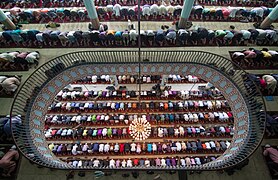Baitul Mukarram National Mosque
| Baitul Mukarram National Mosque | |
|---|---|
বায়তুল মোকাররম জাতীয় মসজিদ | |
Islamic Architecture | |
| Founder | Government of East Pakistan |
| Funded by | Abdul Latif Ibrahim Bhawani |
| General contractor | Thariani & Co. |
| Groundbreaking | 27 January 1960 |
| Completed | 1968 |
| Specifications | |
| Capacity | 42,000+ |
| Height (max) | 99 feet |
Baitul Mukarram, also spelled as Baytul Mukarrom (
History

The mosque complex was designed by architect,
The mosque complex includes shops, offices, libraries and parking areas within it. Unusually, the mosque does not have a dome.
In 2008, the mosque was extended, financed by a donation from the Saudi government.[7][8]
Architecture
The mosque has several modern architectural features whilst at the same time it preserves the traditional principles of Mughal architecture which has for some time been dominant in the Indian sub-continent.[citation needed] Baitul Mukarram's large cube shape was modeled after that of the Kaaba at Mecca,[4] making it a noticeable structure unlike any other mosque in Bangladesh.
Exterior design
The mosque is on a very high platform. The Baitul Mukarram National Mosque's building is eight storied and 99 feet high from the ground level. According to the original plan, the main entrance of the mosque was to be on the eastern side. The 'shaan' on the east is 29,000 square feet with ablution space on its south and north sides. Ablution or Wu’du Place cached an important part when the Baitul Mukarram was begun. The absence of a dome on the main building is compensated by the two superficial domed entrance porticoes, one on the south, and the other on the north. The height of these porticoes consists of three rabbit's foot shaped arches, the middle of which is bigger than the rest.
Interior design
Two patios (roofless inner courtyard) ensure that enough light and air enter the prayer hall of Baitul Mukarram National Mosque. The prayer niché of the hall is rectangular instead of semi-circular. Excessive ornamentation is avoided throughout the mosque, since minimizing ornamentation is typical of modern architecture.
Garden
The garden is laid out in a style borrowed heavily from
Khatibs
| Serial No. | Name | Term | Notes |
| 1 | Abdur Rahman bekhud (1904–1987) | 1963–1971 | |
| 2 | Usman Madani | 1971 | Acting |
| 3 | Amimul Ehsan Barkati (1911–1974) | 1971–1974 | |
| 4 | Abdul Muiz (1919–1984) | 1974–1984 | |
| 5 | Ubaidul Haq Jalalabadi (1928–2007) | 1984–2007 | Longest-serving khatib[9] |
| 6 | Muhammad Nuruddin (1954–2009) | 2007–2009 | Acting |
| 7 | Mohammed Salahuddin (1944–2022) | 2009–2022 | Retired |
| 8 | Ruhul Amin Faridpuri | 2022–present |
Gallery
-
Corridor
-
Design of inner arch
-
Main entrance and Minaret
-
Newly built ceiling
-
Inside view of the Mosque
-
New extension of the mosque
-
Domed entrance porticoes
-
The mihrab
-
Prayer place for the imam (to the left of the minbar)
-
Interior (lower angle)
-
Architecture of Baitul Mukarram National Mosque
See also
- Islamic Foundation Bangladesh
- Timeline of Islamic history
- Islamic architecture
- Islamic art
- List of mosques
- Islam in Bangladesh
- Architecture of Bangladesh
- Haqqani Anjuman
References
- OL 30677644M. Retrieved 28 April 2024.
- ^ Thariani and Co: Architects and Engineers. Booklet in section under projects completed "mosques".
- ISBN 978-0-415-17297-4.
... the Al-Baitul Mukarram, the largest mosque in East Pakistan, which could accommodate 42,000+ devotees for congregational worship.
- ^ ISBN 978-2-88207-006-7.
It takes the historical model of the Kaaba in Mecca as its formal reference. Architect: A.H. Thariani
- ^ "বাইতুল মোকাররমের শুরুর কথা". Daily Inqilab (in Bengali). 28 January 2017. Retrieved 6 December 2022.
- ^ "বায়তুল মোকাররমে প্রথম নামাজ আদায়ের ৫৮ বছর". Kaler Kantho (in Bengali). 25 January 2021. Retrieved 6 December 2022.
- ^ "Saudi donation for extension work of Baitul Mukarram National Mosque". The Daily Star. 21 October 2008.
- ^ Kollol, Kadir (14 April 2021). "বায়তুল মোকাররম: পারিবারিক উদ্যোগে তৈরি হয়ে যেভাবে বাংলাদেশের জাতীয় মসজিদ হয়ে উঠলো". BBC Bangla (in Bengali). Retrieved 6 December 2022.
- ^ "Khatib Obaidul Haq passes away". The Daily Star. 8 October 2007.













